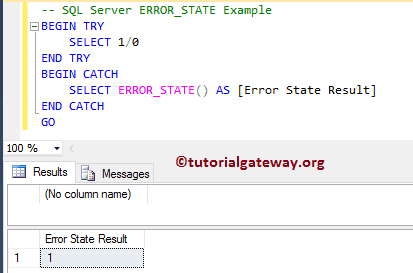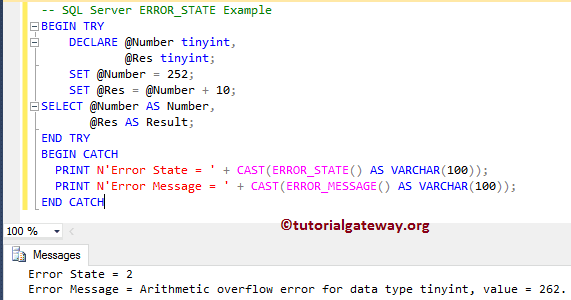SQL ERROR STATE is one of the SQL System Function which returns the state of the error (if occurred). This SQL ERROR STATE function works within the scope of a CATCH block. If you call this function outside the CATCH block, it will return NULL.
For example, we write a series of statements inside the TRY block. And if the server finds an error, then SQL Server ERROR_STATE() inside the CATCH block will be executed, and return an integer value. The basic syntax of the Error_State in SQL Server is as shown below:
ERROR_STATE()
SQL ERROR STATE example
In this example, we are going to show you how to use the Error_State function to find the error severity.
BEGIN TRY
SELECT 1/0
END TRY
BEGIN CATCH
SELECT ERROR_STATE() AS [Error State Result]
END CATCH
GO

ERROR STATE Example 2
It is another example to demonstrate the SQL Server Error_State function.
BEGIN TRY
DECLARE @Number tinyint,
@Res tinyint;
SET @Number = 252;
SET @Res = @Number + 10;
SELECT @Number AS Number,
@Res AS Result;
END TRY
BEGIN CATCH
PRINT N'Error State = ' + CAST(ERROR_STATE() AS VARCHAR(100));
PRINT N'Error Message = ' + CAST(ERROR_MESSAGE() AS VARCHAR(100));
END CATCH

In this SQL Server query, we declared two tinyint variables. Next we assigned 252 to @Number variable, and then we added 10 to that variable which will become 262 (Result).
SET @Number = 252; SET @Res = @Number + 10;
As we all know that tinyint holds numbers from 0 to 255 means Overflow so, it will exit from the TRY block, and execute the Sql Server error state statements inside our CATCH block. We used the ERROR_MESSAGE function to display the error description
PRINT N'Error State = ' + CAST(ERROR_STATE() AS VARCHAR(100)); PRINT N'Error Message = ' + CAST(ERROR_MESSAGE() AS VARCHAR(100));
